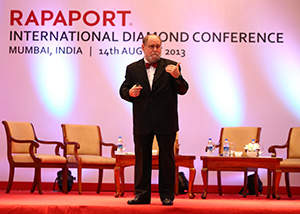|
Industry
Rapaport International Diamond Conference
By Zainab Morbiwala
 |
|
Taj Lands End Hotel, Mumbai, India.
Photo courtesy Taj Hotels Resorts and Palaces.
|
The diamond industry received a morale boost and industry players a reality check from Martin Rapaport during the annual Rapaport International Diamond Conference (IDC) held in Mumbai on August 14. Mincing no words, Rapaport, chairman of the Rapaport Group, described the industry as dominated by a “three-ring circus” of rough buyers who could be divided into categories of “peacockers,” “Ponzi players” and “downstreamers,” all of whom were buying rough at any price.
Whereas peacockers parade in front of the miners and, without blinking, buy rough just to show off their ability to pay the price being demanded, Rapaport said the Ponzi players pay the higher price just to maintain their inventory levels. As for the downstreamers, they pay the rough prices and attempt to make money by tying the new rough to the polished they already have. Warning that the three-ring circus is unsustainable for the industry because all the players will eventually run out of money, Rapaport said, “Less profit will result in less credit and less liquidity.”
Avi Krawitz, senior analyst for the Rapaport Group, told the audience that while India continues to dominate the headlines as the largest manufacturing center in the world, in terms of growth, the India and China story has stalled. As evidence, Krawitz cited the muted response at the recent India International Jewellery Show (IIJS), where buyers were seen pushing for higher discounts.
There also is a corporatization of diamond mining going on in the market, according to Krawitz, leading some to suggest that eight out of every ten mining companies could be publicly traded in the future. As evidence, he cited ALROSA’s plan to issue an initial public offering (IPO) — its first ever — in the fourth quarter of 2013. The same forces are expected to lead to consolidation among midtier mining companies.
In ten hours of individual presentations and panel discussions, the conference attendees heard the industry’s stalwarts assess the current state of the diamond business — its challenges and its potential — and what industry players must do to move themselves, their businesses and their industry to greater prominence and profitability going forward.
In a market where the potential for growth and profitability is limited, Suresh Surana, founder of RSM Astute Consulting Pvt. Ltd., stressed the need for industry players to be disciplined in their operations and to improve their bottom lines by careful inventory management, streamlining of operating costs and strategic use of technology, including social media, in promoting their businesses.
Surana said that at the same time there has been a significant improvement in the U.S. economic outlook in the past six months, the eurozone continues to be challenged by recession and growth is slowing in developing countries. The industry sees the greatest potential for future market growth in India, despite a recent slowdown there, and in China.
The “significant weakening of India’s economic growth outlook” has resulted in reduced foreign investment and high current account deficits, according to Surana, which in turn have played a role in the devaluation of the rupee to record lows. “In the past three months, we have witnessed a 12 percent depreciation of the rupee and it will continue to be under tremendous pressure for the next six to eight months,” he cautioned the audience.
“We shouldn’t be too optimistic about any long-term international capital and investment coming into India,” cautioned Colin Shah, managing director of Kama Schachter, in light of the country’s current instability on many fronts, including politically. “The gems and jewelry industry is facing slowdown blues, with a continuing squeeze on liquidity and increasing back costs. The rough prices continue to leave manufacturers with inadequate or zero profit.”
Kent Wong, managing director, Chow Tai Fook Jewellery Group Ltd., said that in the past ten years, per capita income and consumption in China have grown by more than 200 percent and in 2015, China will be one of the largest global markets for jewelry. But Michael Huang, managing director of Diamond Index Group, cautioned those intent on entering the Chinese market. He advised them that the following ingredients were imperative in making that move: an understanding of the local market, a reliable local team, a matching local partner and access to U.S. currency for memo transactions.

|
| Martin Rapaport |
Throughout the industry, credit lines are being reduced and liquidity is tight. Conference speakers were unanimous in advising the industry to operate responsibly in the current tough credit environment, being careful to stay in compliance with government regulations and institutional restrictions. The overall message: Keep in mind that if money is borrowed from the bank, then the money doesn’t belong to the company but to the bank and it has to be responsibly managed and repaid.
- Surana pointed out that capital and energies need to be wisely used to enhance the core diamond business instead of digressing into such fields as the stock market and real estate. “In the next two to three years, businesses will have to re-engineer and concentrate on their core businesses.” He also advised the audience to seek out innovative, alternative instruments of investment in raising capital for their businesses.
- Rajiv Mehta, director of Dimexon Group, agreed, noting that “We don’t do different things but do things differently. We are in the business of selling diamonds and that is it. We need to remain true to the core of B2B business and offer quality, service and timely service to all our clients.”
- On behalf of banks, Biju Patnaik, senior vice president and regional head for Asia’s India Diamond and Jewelry Group (ID & JG) at ABN AMRO, advised, “Don’t make decisions that cause your company to lose money. Use capital wisely and pay interest from the cash flow and not from your capital. Banks automatically become weary of companies that expand too fast. If you are not creating positive cash flows, slow down your expansion.”
Vishal Doshi, group executive director of Shrenuj & Co. Ltd., said manufacturing in the future will be affected by continued pressure on profit margins — which caused the industry margin to decline by $700 million in the past year — by beneficiation in producing countries and by the migration of skilled labor. He stressed the importance of research and development (R&D) in paving the way for the future but expressed concern that R&D “as of now is largely ignored because we are spending less than 1 percent of our total revenue on R&D activities.”
Arnav Mehta, director of Blue Star Diamonds, offered these suggestions to manufacturers.
- Think international. Do not wear blinkers. Think outside of Surat for the processing of rough. There is cheap and more competitive labor available in other locations.
- Think value additions. Being cheapest isn’t the only solution.
- Think of alternative sources of financing. Banks aren’t the only option. Look for investors or venture capitalists.
- Think vertical integration and collaboration.
- Think about consumer confidence. Do not forget that the consumer is king.
• Branding. Wong, of Chow Tai Fook, said his company has used a wide range of brands and brand promotions to attract and retain customers but he cautioned that those brands must be designed to reflect regional customer demand and preferences.
• Awareness. Russell Mehta, managing director, Rosy Blue India Pvt. Ltd., said, “I think to get higher prices for diamonds, we need to increase the market size. Unless the consumer buys, we cannot do much. I don’t think we are doing a great job increasing consumers’ desirability for diamonds.” Doshi’s suggestion was to “increase consumer awareness and offer product differentiation.” Arnav Mehta added, “First and foremost, distinguish the consumer base. The first group is the one that buys diamonds for their glamour and the second buys diamonds as an investment. Creating confidence in diamonds’ value will automatically increase demand.”
• In the store. Sachin Jain, managing director of Forevermark, calls his company’s focus “magic on the floor.” He spoke of various initiatives undertaken by the brand to win customer loyalty, including having a unique number engraved on each Forevermark diamond. He also shared the importance of educating the customer in what makes diamonds so expensive, citing such activities as showing pictorial representations of the journey of diamonds from mines to market in the store itself. Jain also stressed the importance of treating the staff well and giving them the designation of “brand ambassadors.”
• Price and purity. Sandeep Kulhalli, vice president of retail and marketing for Tanishq, attributed the success of his company’s brand to its ability to create excellence across the value chain — design, manufacturing, merchandising, marketing and retailing — and always having a customer-centric approach. He described diamonds as “a very emotional category, evaluated in the most rational of terms.”
• Aspirational and stable. Ghanshyam Dholakia, managing director of Hari Krishna Exports Pvt. Ltd. and its brand Kisna, recommended acquainting the consumer with diamond jewelry at prices they can afford and creating an aspirational value for diamonds. He also emphasized the importance of maintaining fixed prices — no discounts and no bargaining on price —to make the customer feel secure in the value of his purchase.
• Skew younger. B. S. Nagesh, founder of the TRRAIN Foundation and vice chairman of Shoppers Stop, said retailers need to concentrate on consumers between the ages of 35 to 45 because they have the money to spend and are receptive to aspirational messages. He also recommended building capabilities at the front end to make jewelry retailing a memorable experience for the customer.
On the subject of recycled diamonds, Ezriel Rapaport, director of global trading for the Rapaport Group, described how they are gaining momentum and acceptance. “There are more recycled diamonds coming out of America than what we see coming out of Africa!” he said in urging the diamond industry to stand behind their diamonds.
On the subject of synthetic diamonds, Mark Brauner, co-chief executive officer (CEO) of International Gemological Institute (IGI) Worldwide, and Mehmet Can, general manager of HRD Turkey, stressed that synthetic diamonds were here to stay, that distinguishing them from natural diamonds was proving difficult and that some industry certification system is needed to identify smaller stones as synthetic. “The production of synthetics has increased and it will not stop,” said Brauner. He noted that a survey done in the United Kingdom found that 25 percent of respondents do not mind synthetic diamonds because they are conflict-free, environmentally friendly and come with a competitive price. “Embracing this product is the only choice the industry has,” he said.
Warning that the current market — plagued by players buying rough at crazy prices, manufacturers enabling miners by paying the higher prices and the industry fueling the fire with credit for unprofitable manufacturing — is “unsustainable and unstable,” Martin Rapaport laid out a blueprint for the industry to use in moving into a more responsible, profitable future. His recommendations:
- Get ahead of the curve.
- Legitimize and pay taxes.
- Reduce credit reliance.
- Stop unprofitable manufacturing.
- Buy polished instead of rough.
- Avoid unsustainable subsidies and diligently cease activities that are not profitable.
- Pay attention to the development of the investment diamonds market.
- Operate transparently and secure consumer confidence.
“While the short-term market outlook is problematic,” Rapaport concluded, “there is a great long-term opportunity for firms that legitimize their operations, avoid unsustainable subsidies and diligently cease unprofitable activities.” Article from the Rapaport Magazine - September 2013. To subscribe click here.
|
|